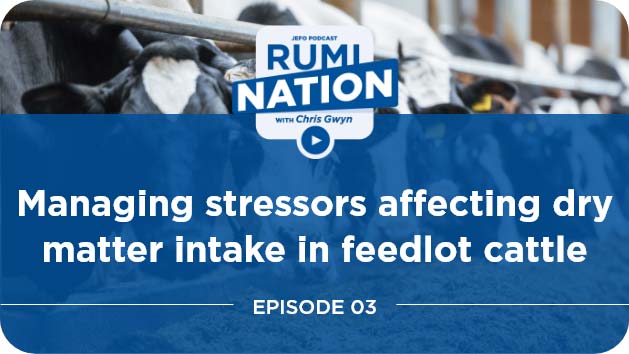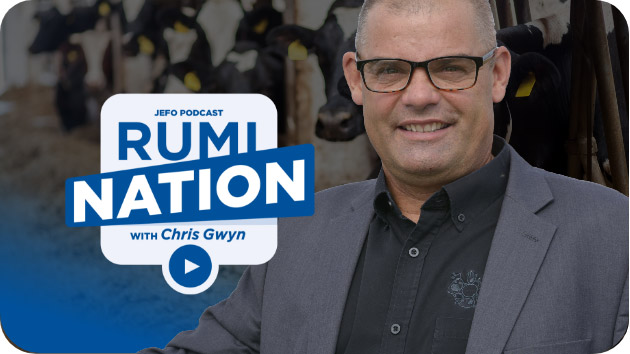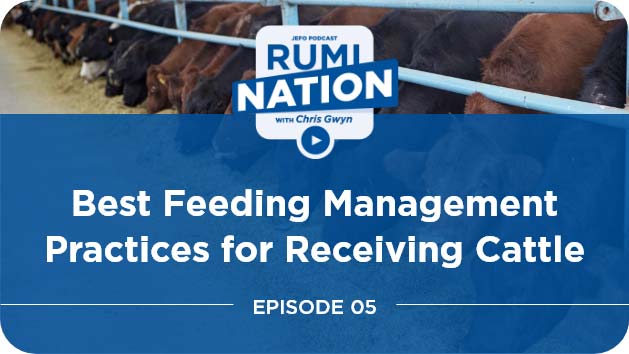RumiNation | S02 : E04
Understanding & Minimizing the
Risk of Acidosis in Feedlot Cattle
Brought to you by Jefo Nutrition
Share now!
Did you enjoy this episode?
Share now!
Understanding & Minimizing the Risk of Acidosis in Feedlot Cattle
What causes acidosis in feedlot cattle? Is the risk of acidosis greater in beef cattle then in dairy cattle? How could we prevent it? Can acidosis also cause other health issues?
Get answers and more with expert Dr. Penner.
Our guest - Dr. Gregory Penner
Dr. Gregory Penner is a professor at the University of Saskatchewan and U of S Centennial Enhancement Chair in Ruminant Nutritional Physiology.
Research projects
- Ruminant nutritional physiology
- Cattle nutrition to enhance health and productivity
- Gut function

Timestamps & Summary
00:40:00 – You recently participated in the annual Jefo Beef Academy where you made a presentation about the acidosis risk and practices to minimize it. Could you summarize some of the key points of that presentation?
We see subtle differences between beef cattle and dairy cattle.
When we look at dairy cattle, a diet that is high in starch and fairly low in fibre only gives a very high volatile fatty acid (VFA) load.
As for the feedlot cattle, the same diet leads to a lot of fermentation in the rumen, which causes the lactic acid to accumulate and has the potential of dropping the pH further than the volatile fatty acids.
Dr. Penner highlighted how this happens and the negative consequences on the gut and what it means for the whole animal perspective. He also found out that the primary risk factors for feedlot operators are health events that cause reduction in feed intake.
03:58:00 – Can you expand on that?
For example, the feed intake of a cattle with respiratory disease may drop by 80% for 5 to 7 days. As they start to recover and rebuild intake, the microbial load in the ruminant also recovers very fast. But the cattle are just not equipped to deal with this rapid increase in acid production, which increases risk for rumen acidosis.
Other events causing reduction in feed intake are heat stress, variable feeding patterns and remixing events. We think it might cause a feed intake response and increase the risk for rumen acidosis.
05:36:00 – So the secondary health events are creating the risk for acidosis versus vice versa?
We think it’s both ways. Lameness, for example, definitely increases the risk for acidosis as the feed intake is reduced. But if we have acidosis, there are also more subsequent risks for lameness.
6:57:00 – There are also discussions about the immune system activation and energetic costs. Could you expand on that?
When we have a low pH in the ruminant, we have a pH drop in the gut. Bacteria then cause a pro-inflammatory response in the gut. If bacteria enter the systemic or blood flow, we can see another inflammatory response partially mediated by circulating immune cells, but also by the liver, which has an enormous energy cost. That’s been looked out a lot in the dairy world.
If we extrapolate to growing and finishing cattle, they are deposing an enormous amount of fat and protein on a daily basis. Both of these processes take substantial energy, and if the energy is diverting to critical functions like the immune system, it probably explains why we have decreased feed conversion and lower energy intake when those cattle are sick.
We’re probably giving up carcasses because they are battling an immune response that is diverting some of the energy and protein that would otherwise be available for tissue growth.
11:05:00 – What would be the key take-home messages for the audience on managing the nutrition of those receiving cattle?
We’ve learned a lot in 30 years, and the management practices we’ve implemented have largely corrected for the acidotic events that we used to see. But late finishing still remains a problem, and we think there’s also a problem related to disease incidents. Early work supports that, but it’s not well defined.
The key questions are: What do we dot with the sick animals? How can we reduce the risk of them getting sick, and can we accelerate how fast they recover? There is still a lot to discover.







